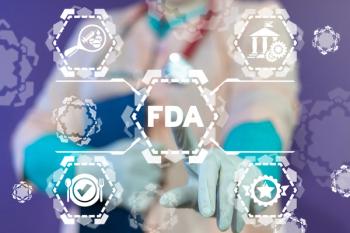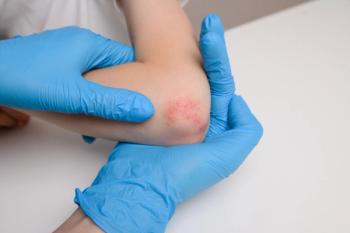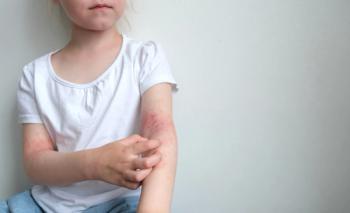
How to Treat Acne in Transgender Patients on Testosterone
Patients on testosterone for masculinizing hormone therapy are at an increased risk of acne due to both inside and outside factors. Matthew David Mansh, MD, FAAD, explains his process for treating these patients.
The treatment of acne is one of the staples of a dermatologist’s daily practice. But how do the outside factors of hormone therapy and chest binders complicate the care of these patients?
Matthew David Mansh, MD, FAAD, assistant professor of dermatology at the University of Minnesota in Minneapolis, discussed the differences in care that physicians must keep in mind when seeing these patients at the American Academy of Dermatology Annual Meeting, held March 25 to 29, in Boston, Massachusetts.1
In the presentation, “LGBTQ/SGM Health in Dermatology: Essentials and Updates,” Mansh reviewed the basic pathophysiology, epidemiology, and risk factors for acne among transgender and gender diverse patients receiving masculinizing hormone therapy (MHT). MHT is used to promote the development of secondary sex characteristics associated with an individual’s gender identity.
For the general population, up to 95% of adolescents report having had acne at some point in their lives.2 Additionally, according to Mansh, adults 25 years and older have a 55% chance of experiencing acne. The psychosocial effect is also higher than the general population, with an elevated risk of depression and anxiety.
Hormonal acne is caused in part by sebum overproduction due to endogenous androgens such as dehydroepiandrosterone, dehydroepiandrosterone-sulfate, androstenedione, testosterone, and dihydrotestosterone. Estrogen, however, reduces sebum production.3
Individuals taking testosterone for gender affirming needs tend to develop acne in similar locations as other hormone-based acne, including the lower third of the face, chest, upper arms and back.Additionally, time of onset for this form of hormonal acne is within 2 years of starting testosterone treatments.3
In his presentation, Mansh highlighted a cohort study of 988 patients receiving MHT with the objective to evaluate the risk of acne in a large population of female to male transgender patients and the clinical risk factors for acne diagnosis. The study found that the prevalence of acne in these patients increased from 6.3% to 31.1% following MHT initiation.4
In addition to the use of testosterone in acne development, he noted that the common use of breast binders in this population could also be a factor. A binder is worn tight on the chest to flatten the breasts. These items are usually made of thick spandex and nylon. The use of binders could create a closed-off bacteria-rich environment that could result in acne patches. There’s even a Reddit thread—/ftm—dedicated to, among other issues in the process of gender affirming treatment, the prevalence of this issue, and what to do you help fix it.5
Mansh also gave tips for the management of acne in these patients, and according to him, the work starts long before the patient enters the practice. To ensure best-in-class care to these patients, adequate training of providers and staff is needed to promote a welcoming environment.
He emphasized the need to be familiar with gender-inclusive language, and the proper use of biologic sex and gender pronouns. Additionally, intake forms and electronic health records must be inclusive of transgender and diverse individuals.
Once the patient has made an appointment, the physician should review their current MHT regimen, according to the presentation. This includes checking drug duration, type, dose, and frequency. It’s important to check the patients’ serum testosterone levels and work closely with their hormone providers to optimize dosing regimens that balance gender-affirming goals and unwanted adverse effects like acne.
For his patients on testosterone with mild to moderate acne, he recommended a topical retinoid with the potential addition of topical antibiotics and benzoyl peroxide. An oral antibiotic may also be considered.
Combined oral contraceptives can be used, however, these patients may be reluctant to use estradiol-containing contraceptives or those with anti-androgens like drospirenone. Mansh noted that there is no data on oral contraceptive use for acne in transgender or gender nonconforming patients on MHT. He also explained that spironolactone should not be used in this population. When considering potentially teratogenic medications, reproductive potential of the patient should guide contraceptive conversations with the patient.
For moderate to severe nodulocystic acne, he prescribes oral isotretinoin. He cautioned that reproductive potential must be accessed in the patient before beginning the iPLEDGE process. Any plans for intended gender-affirming invasive surgeries—top or bottom surgeries— may also impact the timing when starting isotretinoin due to a risk of delayed wound healing.
For those patients with moderate to severe nodulocystic acne that are hesitant to pursue isotretinoin, or the medication is contraindicated, and they have seen no improvement with other topical and systemic therapies, he recommends considering oral finasteride (1-5 mg), low-dose oral doxycycline (40 mg extended-release, or 20 mg twice a day), oral dapsone, or adalimumab, red light photodynamic therapy, and salicylic acid chemical peels.
References
- Peeples JK, Dommasch ED, Mansh MD, et al. LGBTQ/SGM Health in Dermatology: Essentials and Updates. Presented at: 2022 American Academy Dermatology Association Annual Meeting; March 25-29, 2022; Boston, MA.
- Skroza N, Tolino E, Mambrin A, et al. Adult acne versus adolescent acne. J Clin Aesthet Dermatol. 2018;11(1):21-25.
- Radi R, Gold S, Acosta JP, Barron J, Yeung H. Treating acne in transgender persons receiving testosterone: a practical guide. Am J Clin Dermatol. 2022;23(2):219-229. doi: 10.1007/s40257-021-00665-w
- Thoreson N, Park JA, Grasso C, et al. Incidence and factors associated with acne among transgender patients receiving masculinizing hormone therapy. JAMA Dermatology. 2021;157(3):290-295. doi:10.1001/jamadermatol.2020.5347
- r/ftm. Acne from binding. Reddit. Posted 2019. Accessed March 27, 2022.
https://www.reddit.com/r/ftm/comments/8yn533/acne_from_binding/
Newsletter
Pharmacy practice is always changing. Stay ahead of the curve with the Drug Topics newsletter and get the latest drug information, industry trends, and patient care tips.















































































































